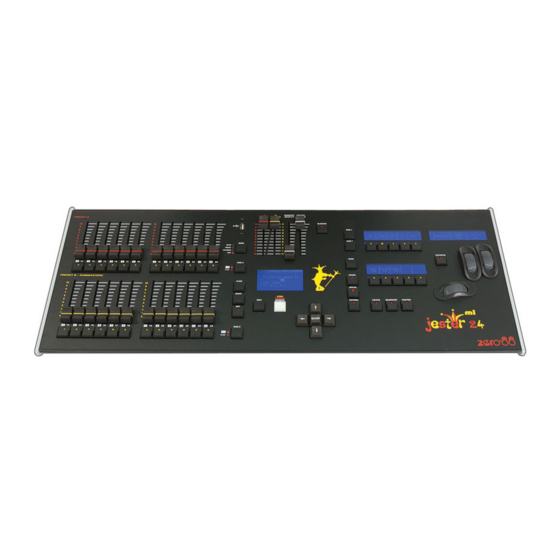
Table of Contents
Advertisement
Quick Links
Advertisement
Table of Contents

Summarization of Contents
Introduction to the JesterML
This Manual
Overview of the manual's content and structure for the JesterML lighting desks.
The JesterML Overview
Introduction to the JesterML lighting desks, their capabilities, and features.
Master Controls and Displays
Key Control Buttons
Explains the function of MODE, GRAND MASTER, and BLACKOUT buttons for desk operation.
Operational Buttons and Entry
Details the PROGRAM/GO button, desk startup sequence, and numeric entry methods.
Preset Mode Operation
Two Preset Operation
Guide to setting up and using two preset scenes with A/B masters for crossfading.
Manual Fading Between Scenes
Instructions for manually crossfading between scenes using A/B masters.
Wide Mode Operation
How to use Wide Mode for crossfading between two scenes using all faders.
Program Mode Guide
Introduction to Programming
Overview of Program Mode for creating memories, submasters, and palettes.
Program Controls and Displays
Explanation of the main controls and displays used during programming.
Programming Scenes and Submasters
Step-by-step guide to creating new scene memories and submasters.
Editing and Overwriting Data
Procedures for editing and overwriting existing scenes, submasters, and chases.
Chase Memories and Steps
Instructions for creating, inserting, and deleting steps in chase memories.
Run Mode Usage
Introduction and Controls
Overview of Run Mode for replaying recorded memories and submasters.
Entering and Navigating Run Mode
Steps to enter Run Mode and select memories/submasters for playback.
Playback of Presets, Submasters, and Chases
How to replay presets, submasters, and control chase playback.
Fixture Control Features
Using Fixtures and Fan Modes
Guide to selecting fixtures, adjusting parameters, and using fan modes.
Palettes, Effects, LTP, and Tagging
Covers programming palettes, movement effects, LTP, and parameter tagging.
DMX Input Configuration
DMX Input Modes and Setup
Explains DMX input modes, wing width settings, and basic operation.
DMX Input Tutorial and Testing
Step-by-step guide for connecting and testing a DMX wing setup.
Setup Mode Options
Introduction and Show Data Management
Overview of Setup Mode, saving, loading, and erasing show data.
DMX Patching and Fixture Assignment
Procedures for patching fixtures and assigning them to DMX addresses.
Record Options and Desk Locking
Configuration of recording modes and securing the desk with a lock code.
Clearing, Resetting, and Library Updates
How to clear data, reset the desk to defaults, and update the fixture library.
Configuration: MIDI, LCD, USB, Help
Settings for MIDI, LCD brightness/contrast, USB, and help language.
Test Mode
For factory and dealer servicing, allows isolated hardware testing of the JesterML.
MIDI Control Functions
MIDI Setup and Communication Basics
Enabling MIDI, understanding communication, and note mapping.
MIDI Received and Velocity Sensing
How the JesterML receives MIDI notes and uses velocity for control.
Additional Features
Online Help System
Accessing and navigating the JesterML's built-in online help.
Software Updates
Procedure for updating the JesterML console software via a USB stick.
Glossary of Terms
Glossary Terms A-E
Definitions of terms from A to E in the JesterML manual.
Glossary Terms F-J
Definitions of terms from F to J in the JesterML manual.
Glossary Terms K-P
Definitions of terms from K to P in the JesterML manual.
Glossary Terms Q-Z
Definitions of terms from Q to Z in the JesterML manual.
Technical Specification
Connections: Power, Audio, Remote, MIDI
Details on the desk's physical input/output connectors and their pinouts.
Interfaces: USB, Video, DMX
Specifications for USB, VGA video output, and DMX input/output interfaces.




Need help?
Do you have a question about the jester ml and is the answer not in the manual?
Questions and answers